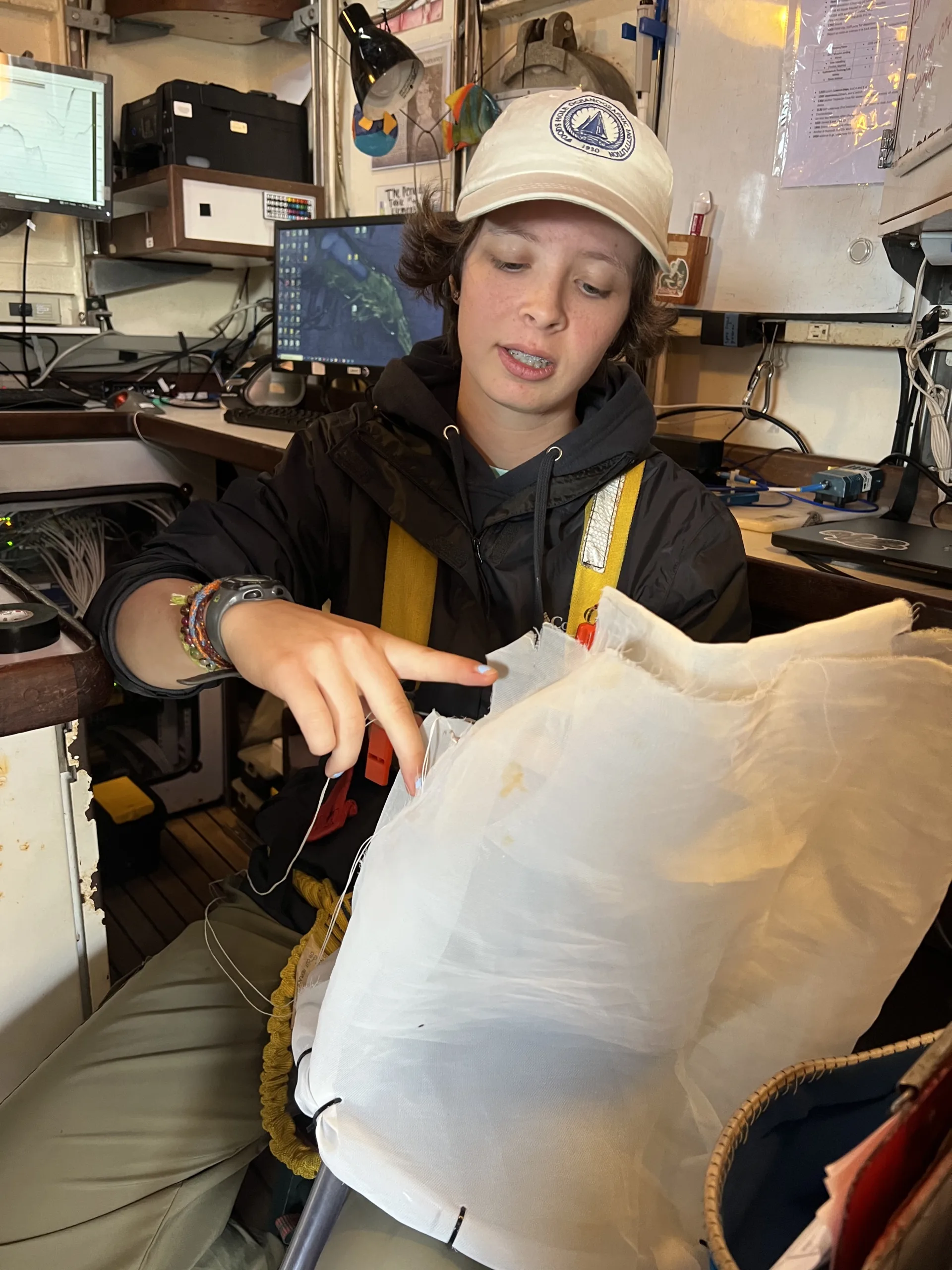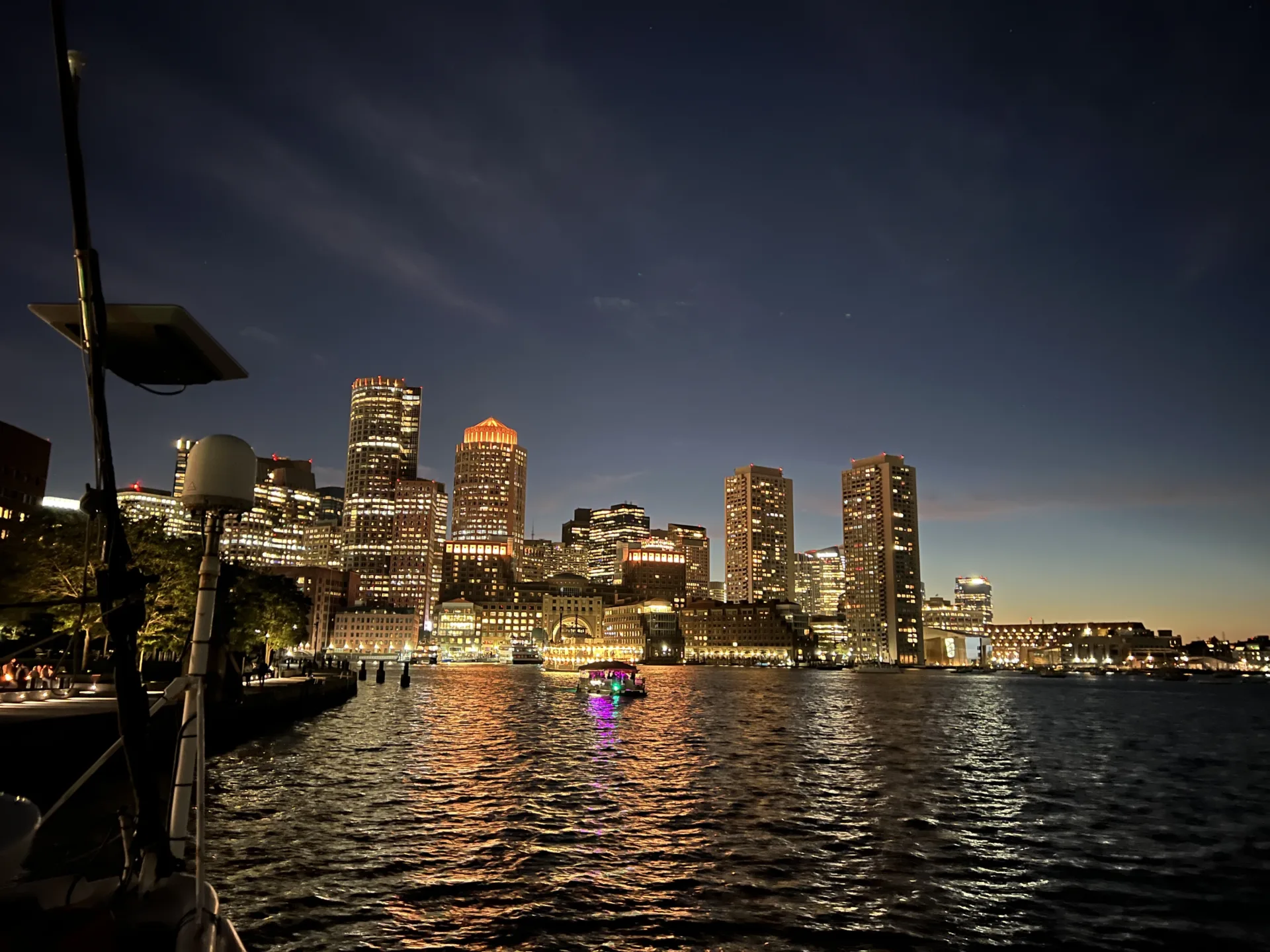Programs Blog
Headed to Boston

Thursday, 21 August, 2025
Position at 1900: 42 degrees 21.3’ N, 71 degrees 2.6’ W
Log (nm): 268.2 nm
Location: Boston Harbor
Following a busy day of ROV deployment on Cash’s ledge, A Watch awoke to find that the waves they had gone to sleep to at 0100 had grown a bit over night. And while B Watch had done a brilliant job of navigating through the chop, with Hurricane Erin inching closer, it was time to take appropriate precautions. And so, the Cramer pushed forth, this time on sail power alone, towards Boston Harbor. However, this did not take away from the important scientific work on which this expedition is based. Even as the hauntingly gray-blue waves mounted, their tips pushing over into white foam, C watch was busy lowering the CTD – a device that measures ocean chemistry vertically through the water column – from the ship’s crane. The CTD, which stands for Conductivity, Temperature, and Depth, has long been a staple of oceanographic research and deploying it on a descent to the seabed around 09:30 every morning has been a staple of our cruise. But of course, our cruise isn’t just about using tried and trusted tools (though they are trusted for a reason) but also aimed at experimenting with robotics and their profound implications for marine science. Unfortunately, weather and depth conspired against our morning ROV deployment. But the same was not true for the Blue Boat. Unconstrained by water turbidity and untethered, we were able to deploy the Blue Boat easily and practiced navigating it rougher seas. In the end, the Blue Boat performed admirably. We are all very excited to deploy it in calmer, shallower waters in order to further test its mapping and autonomous capabilities. That isn’t to say, however, that we did not collect important data. Quite the contrary: if you have been reading our previous blogs, you may have noticed that our student crew has been busy retrofitting attachments to our various robots. These changes have allowed us to collect sample materials that would have otherwise been extremely difficult to collect. One of these changes was a fine net, towed between the Blue Boat’s pontoons, which were able to capture the life teeming at the ocean’s surface, that vast interface between air above and water below. From this net, the A Watch Science Team was able to identify several copepods and make other discoveries, but more on that later.
After the morning robotics work, at 13:00, watch A’s shift began, taking the place of C watch. As we approached Boston we were accompanied by the wind on our backs, and to take advantage of the favorable winds we hoisted the Tops’l to gain additional speed. The process of hoisting the sheet required a large team effort, and multiple people located across the deck to fully alleviate the sheet into its position on the fore-mast. After the hoisting, A watch continued with their duties doing hourly boat checks and weather checks, steering the ship and keeping a look out, and assisting the kitchen in cleaning. Each process requires careful attention to detail, and a keen understanding of the ship’s mechanics. Ultimately – while these processes are minute in their individuality – their combined impacts play a vital role in the ship’s operation, and are parallel in many ways to standard household chores (although in my opinion are far more interesting). The culmination of our skills throughout the expedition in that moment allowed us to complete these tasks like clockwork, and as time flew by, the Boston skyline inched ever closer to our vessel .
Once we had gotten close enough to the shore we took down all of our sails and relied entirely on engine power to make the final few miles into the harbor. Once again, this required strength, teamwork, and determination from the entire crew, and was even more difficult than the initial hoisting of the sails as we had to take them all down (not just the Tops’l) and tie them up neatly so they would not be worn out. We did this to have an easier time docking, as doing so with the inconsistent power of wind is tricky. On the way to the Harbor we saw countless islands, planes (from Logan airport), and many more boats than what we were accustomed to at sea, of which we took countless photos. Finally, after some strategic positioning made by the captain of the ship, we fully landed in Boston, in the Sea Port. At this time (around 21:00), A watch’s shift had ended, and watch B took their place on deck, concluding the adventure of the day, as most people settled down for the night.
The science team in A watch actually did a lot today, including identifying different types of marine creatures. We all learned to use index books and microscopes which are all not that common in our daily life. The first sample we find from the outcome of the blue ROV deployment is several fishes and copepods. It is found interesting that they will change colors after they are dead or dehydrated. I forgot the terminology used to identify those types, but we all enjoy the process of discovery and solving. The next sample we focused on is actually much different. There are bunch of compounds-like things floating in the sample fluid, so it is much harder for us to find and identify organisms. But fortunately, we find some really weird but interesting things, such as ‘eggs’ and some ‘seaweeds’ like things. We didn’t find exactly their types in the books, but we did take pictures of them and see whether we can find them later. It is a great view of the water beside Boston at the sunset time. Most of us ate dinner on deck with winds and colorful sky.
Beckett Nikitas – A Watch
Xiao Feng – A Watch
Julian Schmitt – A watch
P.S.
Beckett: Mom, Dad, and Sienna, All is well here. We are now safely in Boston harbor, and already planning how we can make the best use with the detour we have taken. While life on board can be tiring and difficult, it is most certainly worth it. There is nothing quite like it. I love you all very much and miss you. Love,
Beckett
Julian: Hello fam, I know we already talked a bit but hopefully you can also tell Alexa that I miss her very much. Also make sure that Ray is fully confident in his idea of chasing us at sea, I think that would be very funny. And please do my duolingo 😉
Love,
Julian
Xiao: Mom and Dad, long time without a phone has actually made me anxious. But on the Cramer, we have busy watch to do, either on deck or in lab. So the day goes well and it is about to back to China. It is such a special experience that I have ever and will never encounter in the future. The waves in deep sea is so big, but I have just become used to sleeping in the ‘baby bed’. Missing Shanghai, See you on 27th.
Xiao Feng

Recent Posts from the Ships
- Ocean Classroom 2024-A collaborative high school program with Proctor Academy
- Collaborations and Long-term Commitments: SEA’s Caribbean Reef Program Sets a Course for Coastal Programs that Compliment Shipboard Experiences.
- Sea Education Association students prepare for life underway using state of the art nautical simulation from Wartsila Corporation.
- SEA Writer 2022, Magazines From the Summer SEA Quest Students
- Technology@SEA: Upgrades Allow Insight into Ocean Depths
Programs
- Gap Year
- Ocean Exploration
- High School
- Science at SEA
- SEA Expedition
- SEAScape
- Pre-College
- Proctor Ocean Classroom
- Protecting the Phoenix Islands
- SPICE
- Stanford@SEA
- Undergraduate
- Climate and Society
- Climate Change and Coastal Resilience
- Coral Reef Conservation
- Marine Biodiversity and Conservation
- MBL
- Ocean Exploration: Plastics
- Ocean Policy: Marine Protected Areas
- Oceans and Climate
- Pacific Reef Expedition
- The Global Ocean: Hawai'i
- The Global Ocean: New Zealand